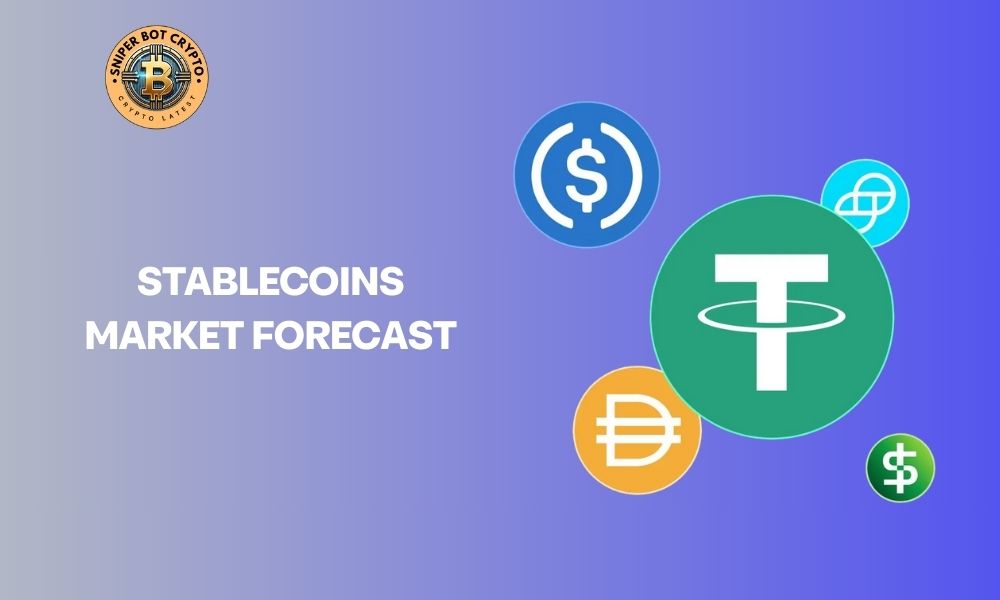In the context of global finance undergoing significant transformations, the stablecoins market forecast has become a hot topic, capturing the attention of both investors and financial institutions. With rapid development, stablecoins are reshaping how we approach payments, cross border transactions, and decentralized finance (DeFi) applications. Let’s explore the promising future of the stablecoin market in the article below.
Contents
The current state of the stablecoin market

Stablecoins, also known as stable digital currencies, are assets pegged to fiat currencies or commodities like gold. Predictions suggest that the total market capitalization of stablecoins will exceed $400 billion by the end of 2025, up from $225 billion at the beginning of the year. Some experts even anticipate this figure could reach up to $1 trillion. This rapid growth reflects the increasing demand for stable, secure alternatives to volatile cryptocurrencies, making stablecoins an essential part of the crypto ecosystem. The stablecoins market forecast suggests continued expansion as more institutional investors and businesses adopt these assets.
Major players such as Tether (USDT) and USD Coin (USDC) currently lead the stablecoin market. However, new competitors offering profitable solutions are gradually intensifying the competition. It’s not just cryptocurrency investors who are getting involved, financial institutions and global businesses are increasingly adopting stablecoins for payments and liquidity management. This broadening adoption highlights the growing importance of stablecoins in the global financial system.
Stablecoins market forecast: Trends shaping the future
In recent years, stablecoins have gradually become an essential part of the digital financial ecosystem. With the strong development of blockchain platforms and the increasing demand for international payments, the stablecoins market forecast predicts that the stablecoin market will experience significant changes. Below are some key trends that are shaping the future of the stablecoin market in the coming years.
Explosion in stablecoin supply
According to the stablecoins market forecast, the supply of stablecoins is expected to increase significantly due to the growing demand for blockchain based financial solutions. Experts predict that the supply of stablecoins could grow by over 340% in 2025, driving widespread adoption of cryptocurrency. This surge is largely driven by financial institutions and fintech companies seeking optimal solutions to mitigate the volatility of other cryptocurrencies while maintaining high liquidity.
This rapid growth will also lead to the diversification of stablecoin types, including those backed by different assets such as gold, fiat currency, or even other digital assets. This creates a rich and expanding ecosystem that not only serves payment needs but also facilitates investment transactions and asset storage.
Acceptance by organizations
Large organizations globally are increasingly viewing stablecoins as a reliable tool for liquidity management and international transactions. Currently, over 25% of businesses worldwide accept payments in stablecoins, especially in the international remittance sector. This helps reduce transaction costs and shortens processing times, providing an efficient solution for cross-border markets.
Moreover, traditional financial institutions are starting to adopt stablecoins to improve efficiency in banking, insurance, and other financial products. This adoption will continue to grow in the coming years as organizations realize the stabilizing potential and transaction cost optimization offered by stablecoins. The stablecoins market forecast indicates that the integration of stablecoins into mainstream financial services will be a significant trend in the near future.
Improved regulatory framework
Legal regulation plays a crucial role in shaping the stablecoin market. In 2025, major economies like the US and EU are expected to implement legal frameworks aimed at ensuring transparency and protecting consumers. For example, the US is considering the STABLE Act, while the EU has introduced the MiCA framework to expand opportunities for organizations to participate. These regulations will help stabilize the stablecoin market and encourage safer involvement from investors.
Clear legal frameworks not only help protect consumers but also create a favorable environment for financial institutions to participate in the stablecoin market. This balance between technological innovation and stakeholder protection will be critical in the market’s maturity. The stablecoins market forecast suggests that the development of these regulatory frameworks will play a key role in the growth of the stablecoin market in the coming years.
Technological advancements
Layer-2 (L2) protocols like arbitrum and optimism are improving the scalability and transaction efficiency of stablecoins. These technologies help reduce transaction costs and speed up processing, particularly for cross border transactions. The combination of stablecoins with L2 protocols will make money transfers faster and more efficient, enhancing the widespread use of stablecoins in practical applications.
Furthermore, the interoperability between different blockchains is opening up new applications for both retail and institutional markets. L2 protocols can help reduce congestion on main blockchain networks, ensuring smoother and safer stablecoin transactions. The stablecoins market forecast indicates that these technological advancements will play a vital role in accelerating the development of stablecoins in the near future.
The emergence of yield-generating stablecoins
Yield-generating stablecoins are becoming increasingly popular due to their ability to provide passive income for holders. Companies like Coinbase have launched reward programs for USDC users, making this asset class more attractive to investors. With interest rates higher than traditional savings accounts, yield-generating stablecoins present an appealing investment option for those seeking a safe way to store assets while earning a return.
Additionally, the rise of Decentralized Finance (DeFi) platforms has opened up new opportunities for yield-generating stablecoins. Holders can participate in lending, staking, or yield farming protocols to earn higher returns from their assets. The stablecoins market forecast shows that the popularity of yield generating stablecoins will continue to rise in the coming years as more people seek safe and effective investment opportunities.
The leaders and new players in the stablecoins market forecast

Tether (USDT) continues to maintain its dominant position in the stablecoins market forecast, with a market capitalization exceeding $143 billion. It is the most widely used stablecoin on exchanges and DeFi platforms, ensuring stability for transactions. With its strong growth, Tether has proven its strength in maintaining a stable value and high liquidity. Additionally, USD Coin (USDC) is also a major player, known for its transparency and backing by major financial institutions. USDC is widely used in DeFi applications, providing absolute trust for its users.
While giants like Tether and USD Coin maintain their positions, the emergence of yield-bearing stablecoins is creating intense competition. BUIDL by Blackrock and USDe by Ethena offer users attractive profit opportunities, instead of just maintaining stable value. This has attracted the attention of investors looking for returns while still keeping the stability of a stablecoin. Another new player, PayPal USD (PYUSD), is also gaining attention due to its deep integration into PayPal’s traditional payment system, helping to expand access for millions of users worldwide.
Factors driving growth according to the stablecoins market forecast
The stablecoins market forecast shows a strong growth potential in the near future. One of the key factors driving the development of stablecoins is clear legal regulations. These regulations not only help strengthen the trust of investors and businesses but also create a transparent and secure environment for transactions. As governments and regulatory bodies provide specific guidelines and regulations, stablecoins will have a solid foundation to develop sustainably in the future.
Another important factor is the integration of stablecoins into international trade. Using stablecoins helps reduce costs and payment processing times in cross border transactions, especially when compared to traditional payment methods. Furthermore, with the development of DeFi platforms, stablecoins are playing a crucial role in enhancing transaction capabilities and creating new opportunities for investors. As blockchain technology infrastructure improves and transaction costs decrease, the use of stablecoins will become increasingly popular and easier for users around the world.
The stablecoins market forecast is set for continued growth, with leaders like Tether and USDC maintaining dominance and new players like BUIDL and PYUSD adding fresh opportunities. As the market adapts to emerging trends, the future looks promising for both investors and the crypto ecosystem. Stay ahead of the curve with insights from Sniper Bot Crypto, your trusted source for the latest in crypto developments.
